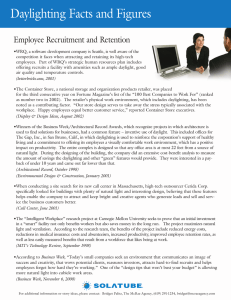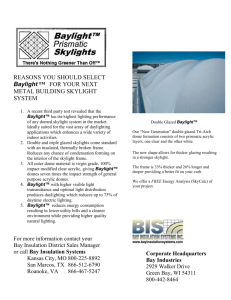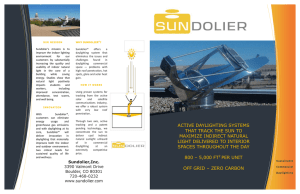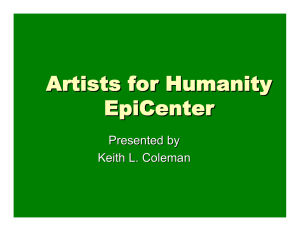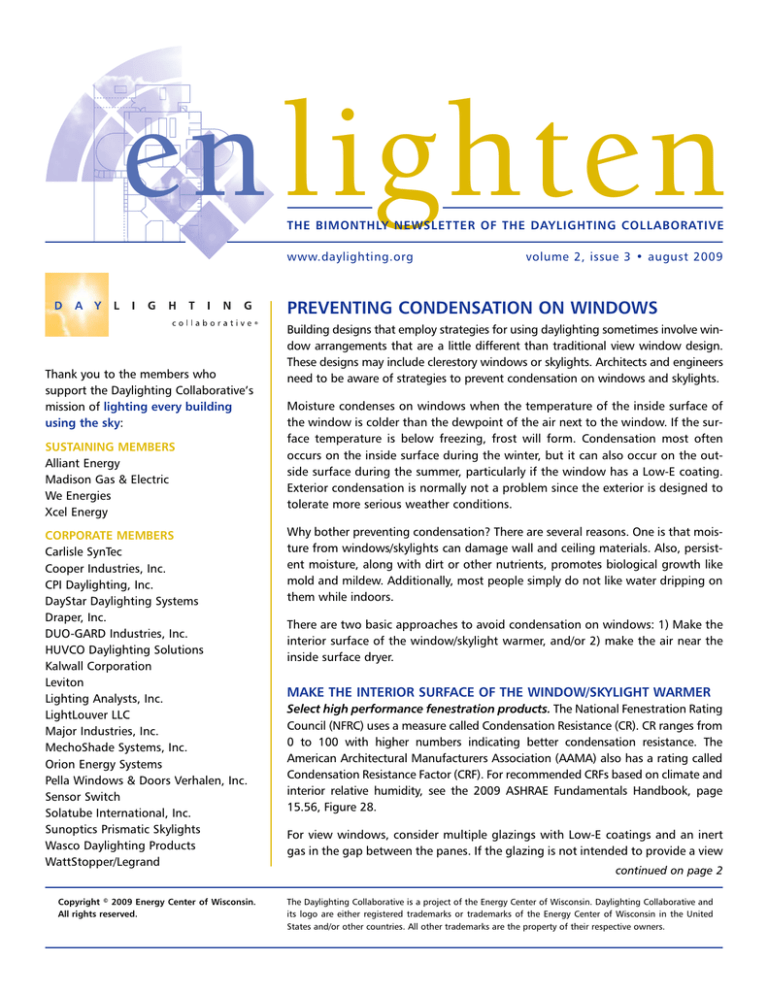
en lighten
THE BIMONTHLY NEWSLETTER OF THE DAYLIGHTING COLLABORATIVE
www.daylighting.org
volume 2, issue 3 • august 2009
PREVENTING CONDENSATION ON WINDOWS
Thank you to the members who
support the Daylighting Collaborative’s
mission of lighting every building
using the sky:
SUSTAINING MEMBERS
Alliant Energy
Madison Gas & Electric
We Energies
Xcel Energy
CORPORATE MEMBERS
Carlisle SynTec
Cooper Industries, Inc.
CPI Daylighting, Inc.
DayStar Daylighting Systems
Draper, Inc.
DUO-GARD Industries, Inc.
HUVCO Daylighting Solutions
Kalwall Corporation
Leviton
Lighting Analysts, Inc.
LightLouver LLC
Major Industries, Inc.
MechoShade Systems, Inc.
Orion Energy Systems
Pella Windows & Doors Verhalen, Inc.
Sensor Switch
Solatube International, Inc.
Sunoptics Prismatic Skylights
Wasco Daylighting Products
WattStopper/Legrand
Copyright © 2009 Energy Center of Wisconsin.
All rights reserved.
Building designs that employ strategies for using daylighting sometimes involve window arrangements that are a little different than traditional view window design.
These designs may include clerestory windows or skylights. Architects and engineers
need to be aware of strategies to prevent condensation on windows and skylights.
Moisture condenses on windows when the temperature of the inside surface of
the window is colder than the dewpoint of the air next to the window. If the surface temperature is below freezing, frost will form. Condensation most often
occurs on the inside surface during the winter, but it can also occur on the outside surface during the summer, particularly if the window has a Low-E coating.
Exterior condensation is normally not a problem since the exterior is designed to
tolerate more serious weather conditions.
Why bother preventing condensation? There are several reasons. One is that moisture from windows/skylights can damage wall and ceiling materials. Also, persistent moisture, along with dirt or other nutrients, promotes biological growth like
mold and mildew. Additionally, most people simply do not like water dripping on
them while indoors.
There are two basic approaches to avoid condensation on windows: 1) Make the
interior surface of the window/skylight warmer, and/or 2) make the air near the
inside surface dryer.
MAKE THE INTERIOR SURFACE OF THE WINDOW/SKYLIGHT WARMER
Select high performance fenestration products. The National Fenestration Rating
Council (NFRC) uses a measure called Condensation Resistance (CR). CR ranges from
0 to 100 with higher numbers indicating better condensation resistance. The
American Architectural Manufacturers Association (AAMA) also has a rating called
Condensation Resistance Factor (CRF). For recommended CRFs based on climate and
interior relative humidity, see the 2009 ASHRAE Fundamentals Handbook, page
15.56, Figure 28.
For view windows, consider multiple glazings with Low-E coatings and an inert
gas in the gap between the panes. If the glazing is not intended to provide a view
continued on page 2
The Daylighting Collaborative is a project of the Energy Center of Wisconsin. Daylighting Collaborative and
its logo are either registered trademarks or trademarks of the Energy Center of Wisconsin in the United
States and/or other countries. All other trademarks are the property of their respective owners.
enlighten
T R A I N I N G U P D AT E
JIM BENYA AND ABBY VOGEN
HORN PRESENT LIGHTING AND
DAYLIGHTING TRAINING AT
GREENBUILD 2009
Daylighting Collaborative Advisory
Committee member Jim Benya and
Abby Vogen Horn will present a preconference workshop, Lighting and
Daylighting Design with Efficiency,
November 10, 2009 at Greenbuild in
Phoenix, Arizona. This full-day training
will examine the latest technologies and
strategies to achieve superior lighting
design that is essential for energy efficient and high performance buildings.
The training is designed for architects,
engineers, lighting designers, contractors, interior designers, lighting contractors, manufacturers, dealers and
distributors, lighting wholesalers and
distributors and anyone interested in
commercial building design. The
USGBC has approved this training at
the 300 level and AIA members will
receive 6 HSW/SD learning units. The
training has also been approved by
NCQLP for 6 lighting education units.
You do not need to register for the
Greenbuild conference to register for the
course. To register, you will need to complete the Greenbuild registration form at
www.greenbuildexpo.org/schedule.
Register by September 7, 2009 to receive
the Early Bird Special rate.
For more information on the topic and
detailed registration steps, please visit
www.ecw.org/university and click the
“Lighting and Daylighting Design with
Efficiency” link.
THE BIMONTHLY NEWSLETTER OF THE DAYLIGHTING COLLABORATIVE
continued from page 1—PREVENTING CONDENSATION ON WINDOWS
to the outside, consider translucent materials such as nanogels, glass blocks, or certain plastics that insulate better than glass. These materials also typically have
lower visible transmittances, so more glazing area may be needed to meet the daylighting targets. An energy analysis can determine the energy impact of replacing
well-insulated opaque wall or roof area with glazing. An energy analysis can also
estimate the annual energy cost savings, which may show that a high performance
window/skylight is actually a lower-cost option when the life of the window/skylight is considered (life cycle cost analysis).
Fix leaks. A poor seal or crack can cause cold air to leak through. In these cases the
glazing should be repaired or replaced.
Provide heat near the window/skylight surface. Baseboard convective heaters
under windows are commonly used, but there are limits to the height of a window
it can heat. As the warm air rises, it cools, and it could eventually stop rising if it cools
to room temperature. Radiant ceiling panels can help warm the tops of tall windows.
Blowing warm air onto the window/skylight surface can also be effective, but not if
the fan is shut off for long periods such as overnight. This method is more energy
intensive than the high performance window/skylight, but it may be suitable when
dealing with an existing building.
MAKE THE AIR NEAR THE INSIDE SURFACE DRYER
Making the air near the inside surface of the window/skylight dryer can be accomplished in a number of ways.
Dehumidify the air. Some spaces that typically have high humidity, such as natatoriums, can benefit from a strategy to lower the humidity. As their name implies, dehumidifiers are useful for this purpose. Providing more ventilation air, when the outside
air is dry, may use less energy than a dehumidifier. If a space is humidified, consider
lowering the humidifier setpoint during extremely cold weather. In places where
moisture is added to the air, such as shower rooms or kitchens, prevent the moisture
from spreading to other parts of the building by turning on an exhaust fan.
Provide good air movement at the window/skylight. Air near a cold surface naturally
cools, and as it cools its relative humidity increases. Stagnant or slow-moving air has
more time to become saturated and form condensation. The idea here is to get the
cooled air away from the window/skylight surface before the air cools enough to
become saturated and form condensation. If the supply air from the heating system
does not circulate the room air enough, consider a ceiling fan. Deeply recessed windows, like bay windows, impede good air flow at the window surface. Avoid closing
drapes, blinds or other window treatments that restrict air flow near the surface.
continued on page 3
2
enlighten
UPCOMING EVENTS
THE BIMONTHLY NEWSLETTER OF THE DAYLIGHTING COLLABORATIVE
continued from page 2—PREVENTING CONDENSATION ON WINDOWS
In summary, to prevent condensation on windows, keep the interior surface temperature of the window/skylight warmer than the dewpoint of the air near the surface. Generally this can be accomplished with high performance fenestration and
dry air movement near the surface.
The Daylighting Collaborative will have a
booth at the Greenbuild International
Conference and Expo in Phoenix,
Arizona on November 11–13, 2009.
WEBCASTS
FREE GREEN BUILDING WEBCASTS
IN AUGUST
Energy Center University is offering
free viewing of select webcasts for
commercial and residential builders
during the month of August. These
webcasts are designed for architects,
engineers, builders, remodelers,
energy consultants and others
interested in high performance and
energy efficient buildings. Green
Buildings: Harvesting the Low-lying
Fruit (Architects’ Module 1 of 2) is
presented by Eric Truelove, P.E., LEED
AP and Introduction to Green Building
is presented by Robin Pharo, President,
Healthy Homes. Register today at
www.ecw.org/university and click the
“Summer Special” link.
Powered by the Energy Center of
Wisconsin, Energy Center University
offers live event and online continuing
education programs to more than
4,000 commercial, industrial and
residential building professionals every
year. For more information on Energy
Center University, please visit
www.ecw.org/university.
DID YOU KNOW…
By Donald W. Aitken, Ph.D., LEED AP, Donald Aitken Associates.
HOW CAN DAYLIGHT BE ADMITTED TO A BUILDING WHILE SOLAR
HEAT GAINS ARE NOT?
Only one or two percent of exterior daylight is required to light a building.
Particularly on bright, clear sky, hot summer afternoons when building peak kW
and AC tons capacities are set, only a tiny fraction of outdoor light is required
indoors. In fact, on the very day we would like daylighting to work the best is the
same day daylight is most readily available!
Most windowed buildings let in far more light from the outside than required with
little concern for light quality or cooling load avoidance. All that is required is to
thoughtfully use daylight while avoiding excess heat gains during the hotter
months of the year. For instance, sunlight is typically avoided, while soft diffuse skylight and ground reflected light is welcomed. Vertical glass/clerestories tend to
work better than horizontal glass (skylights), since they admit indirect daylight
while avoiding direct sunlight from the high summer sun. Vertical glass also tends
to admit more light in the winter, when it is physiologically and psychologically
desired (to mitigate Seasonal Affective Disorder) and the heat easily removed by
introducing cool outside air. Western exposures/glass should be avoided, or carefully shaded from the hot late afternoon sun in the summertime.
While cooling load avoidance daylighting strategies apply to air-conditioned buildings, these are the same common sense shading and glare control actions one
would take to stay comfortable in non-air-conditioned buildings.
WHY IS HVAC DOWNSIZING EMPHASIZED WHILE EQUIPMENT
EFFICIENCY IS MADE A SECONDARY CONCERN?
Eliminating the unnecessary is far superior to improving its efficiency, and therefore, should be the first concern. For instance, high performance glazing will generally reduce the required size of the HVAC system, lower peak electrical demand,
lifetime energy use and maintenance costs for a facility and, through first cost reallocation, is less expensive than that portion of the HVAC system it replaces.
continued on page 4
3
enlighten
MORE TRAINING
The Lighting Controls Association
offers free, comprehensive online education about lighting controls technology, application and commissioning:
www.aboutlightingcontrols.org/
Education_Express/welcome.php
Lighting Control & Design’s continuing education courses present the latest technology in lighting controls and
offer professional development credit
for your Architectural (AIA/CES) or
Engineer license renewal. Schedule a
daylight harvesting seminar in your
office or earn credits remotely.
www.lightingcontrols.com/design
/onlinetraining/index.asp
Southface provides education and outreach on saving energy, conserving
water and preserving the environment.
Basics of Daylighting in a Green
Environment offers an introduction to
the use of daylighting in commercial
spaces. The course shows why daylighting should be considered, the basic
guidelines for using daylighting and
some words of caution when using certain daylighting techniques.
www.southfaceonlinetraining.org/
daylighting/about.php
The Collaborative for High Performance Schools (CHPS) has five threehour seminars available on designing
high performance schools.
www.chps.net/events/workshops.htm
The Whole Building Design Guide contains a wealth of information on integrated whole building design techniques
and technologies.
www.wbdg.org/references/
mou_daylight.php
THE BIMONTHLY NEWSLETTER OF THE DAYLIGHTING COLLABORATIVE
continued from page 3—DID YOU KNOW…
Alternately, for example, one could construct an ice storage system to lower peak
electrical demand. Not only does the ice system increase first cost, but it will
increase lifetime maintenance as well. Also, it will need to be replaced two or three
times (incurring that first cost each time) since the system’s useful life is less than
the useful life of the building.
Whether it is dimming ballasts, complicated control systems, or movable louver
shading systems, beware of any component that increases net first cost without
lasting the life of the building. For any component that does not last the life of the
building, the first priority is to downsize, eliminate or simplify it. Smaller equipment
costs less initially, costs less each time it is replaced, and invariably uses fewer
resources and less energy to operate and maintain. Then, and only then, might systems and components that increase cost and complexity, in the name of energy
efficiency, be useful.
MEMBERSHIP
U P D AT E
THE DAYLIGHTING COLLABORATIVE WELCOMES TWO NEW MEMBERS!
MechoShade Systems Inc. has been the
innovator for manual, motorized and
automated solar shading and room darkening solutions for over 30 years.
MechoShade Systems Inc. develops energy efficient solar shading at the window wall to achieve personal, thermal, and visual comfort in conjunction with
the more efficient use of natural resources.
Orion Energy Systems serves manufacturing, industrial, warehousing and commercial industries with a
suite of proprietary, energy-efficiency technologies
that reduce energy consumption by 50 percent or more, while increasing the
quality and quantity of light, and reducing greenhouse gas emissions.
We’re grateful to all our members for their generous support and collaboration in developing and delivering the resources the building design community needs to light every building using the sky.
4

